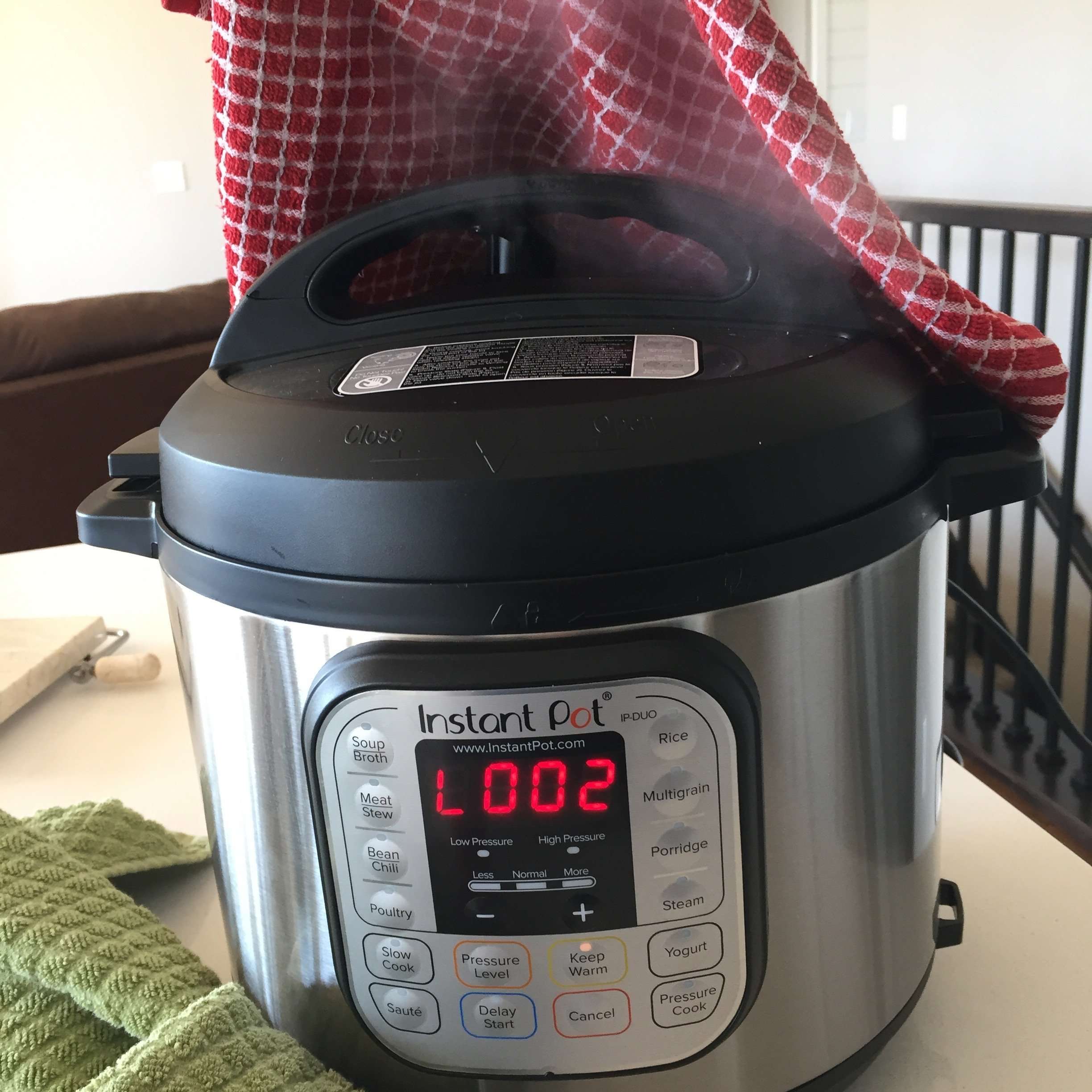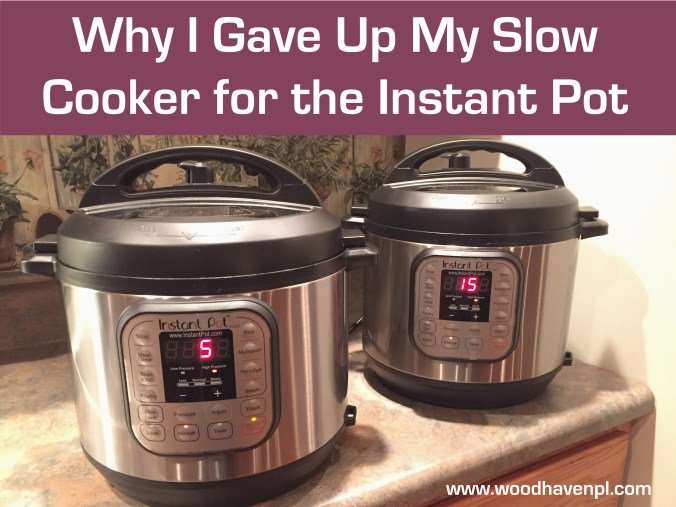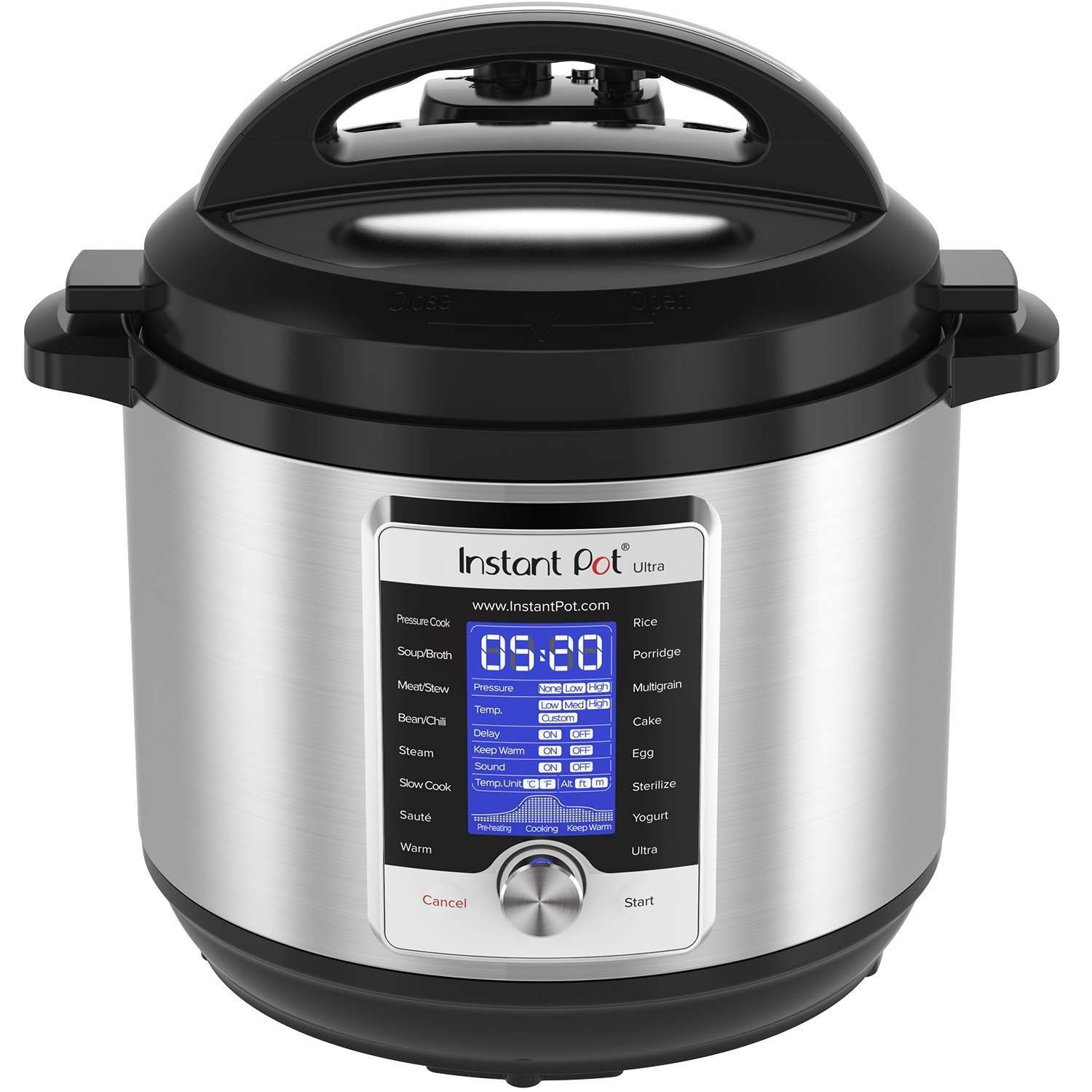My Pot Is Kind Of Stinky
The rubberized sealing ring of the Instant Pot can absorb odors easily, especially when pressure cooking. If you are cooking a particularly pungent meal, the ring may retain the smell, which is annoying when making a different meal. Garlic smells may be the most common, but it can happen over time with a variety of odors.
If the odor is causing problems, take your sealing ring out and try washing it in the dishwasher. This can remove some of the worst of the smell and get the ring back into working order. You may also want to try soaking it in a pan of warm water mixed with baking soda to absorb as much of the odor as you can. Some people even choose to purchase a spare sealing ring and use one for meals and one for desserts.
How To Do A 10 15 Minutes Natural Pressure Release
After the cooking cycle finished, wait 10 15 minutes before moving the Venting Knob from Sealing Position to Venting Position to release the remaining pressure.
Always make sure the Floating Valve completely drops before opening the lid.
Whats the advantage?
- Compare to Quick Release:;Significantly reduces the;chance of food splattering out from the Pressure Release Valve.
- Compare to Natural Release:;Faster release method when the pressure cooker is full of food with high liquid volume.
Use Rice Button For Cooking All Types Of Rice
Mistake: Weve heard some new Instant Pot users have less than satisfactory results with their rice cooked in the Instant Pot using the Rice Button.
Dont be discouraged!
Solution:;Different types of rice require different water to rice ratios&cooking times. For best results, we like to use the Manual Button for most control on Cooking Method & Time.
Here are our Perfect Rice Recipes:
Recommended Reading: How To Cook Tuna Steak In Instant Pot
How To Know When Instant Pot Natural Release Is Done
- Save
Instant Pot is a trendy kitchen tool. Using it in your daily life cooking isnt that hard. With its user manual and less complex equipment, it gets quite handy even for amateur cooks to go on a wild cooking journey. Although, it is quite intimidating to cook with Instant Pot, especially for newbie cooks, when it comes to knowing if the natural pressure release is done or not. You can easily find out if the natural release is done when the float valve is at the level of the lid. In this way, Instant Pot would not be sealed and the natural pressure release would be done. However, there is much more to the natural release of the Instant Pot, we will walk you through all the relevant details in this article. Stay with us!
Recommended Reading: How To Instant Pot Chicken Breast
Clean And Store It Well

This goes for the food and the equipment. The materials that most pressure cookers are made out of are not designed for food storage. Once youve cooked your dish, decant it to something else for storage to avoid erosion or marking.
Pressure cooker lids are not designed for the dishwasher or for immersion in water. Wash them under a running tap and clean with washing up liquid, taking off the rubber gasket for a proper clean. Some pots are suitable for dishwashers, others not. Check the instructions. Otherwise wash in the sink.; Other parts dont need to be taken apart and cleaned individually every time but will do if they become blocked. Instructions will explain how to do this.
Dry your pressure cooker thoroughly. Leaving it out on a tea towel, rather than popping it straight in the cupboard will allow air to circulate. Rest the lid upside down on top when storing rather than fitting it on the pot.
Also Check: Ahi Tuna Instant Pot
If You Forget To Seal Your Instant Pot’s Valve The Appliance May Not Work Properly
The Instant Pot uses extreme pressure and heat to cook ingredients, which is why it cooks meals so much faster than a stove or slow cooker.
This means that you need to make sure the appliance is properly sealed or your food won’t cook properly.
“One common mistake that people make when using the Instant Pot is forgetting to set the valve to the sealing position,” Carrie Forrest, creator of Clean Eating Kitchen and author of the official Instant Pot book, “Healthy Meal Prep Instant Pot Cookbook,” told Insider. “You will know that you may have forgotten to set the valve to ‘sealing’ when you hear air escaping from around the sealing ring after the pot has come up to pressure.”
To fix this, simply cancel the cooking time and carefully set the valve to the sealing position rather than the venting setting. Then, reset the cooking time and restart the Instant Pot.
Q: What Is A Natural Pressure Release
A natural;pressure release is when you leave the pressure release switch in the Sealed position when the cook time ends. This lets the pressure release slowly, without you doing anything.;When the pressure is fully released, the float valve will drop and the lid will unlock and;open.
A natural pressure release is a bit anticlimactic in comparison to a quick pressure release. There is no jet of steam when the natural pressure release starts. Theres also no clear way to tell when the pressure is fully released, and no beep or signal when the lid unlocks. Sometimes you can hear the float valve drop if youre close by.
The time it takes for the pressure to release naturally will vary depending on the ingredients and amount of liquid in the pressure cooker.;A natural pressure release can;take from 5;to 30 minutes in the electric pressure cooker.
Food inside the cooking pot will continue to cook as the pressure decreases.
You May Like: How To Convert Slow Cooker To Instant Pot
How To Cook Beans In The Pressure Cooker Or Instant Pot
Heres how to cooker beans in the pressure cooker or Instant Pot:
Have you tried making your own beans? Any favorite seasonings or cooking tips to add to mine? Please share your advice and recipes below.;
What Is The Difference Between A Quick Pressure Release Or Natural Pressure Release And When Do I Use Them
Those are often the first questions new pressure cooker users ask. So I thought it would be a perfect time for a post explaining it for all those who have an electric pressure cooker or multi-cooker like the Instant Pot waiting for them under the tree.
When the cook time ends, your pressure cooker will beep. At this point, the recipe will direct;you to release the pressure in the cooking pot. You can release the pressure two ways: a quick pressure release or a natural pressure release.
I really like the way the Instant Pot summarizes the two pressure releases:
Now for the details:
Recommended Reading: How To Cook Hoppin John In Instant Pot
Pressure Isnt Building In My Pot
This usually happens when the pressure release valve has been turned to open when you sealed the lid, but you didnt notice at the time so steam is just slowly leaking out of the pot as it tries to heat up. This isnt good for the food inside, and it keeps the pot from actually reaching the correct pressure levels.
The best solution for this is to get in the habit of always checking the pressure valve when you seal the lid. Just look and make sure its in the locked position before you select your pressure cooking setting.
How Rapid Release Works And When To Use It
All electric pressure cookers have a pressure-release valve on the lid. Rapid release works by turning, lifting, or pressing the valve once active cooking is complete. This process takes an extra degree of care, as a loud burst of steam is released from the valve. Rapid release takes no more than a minute or two, and works best with foods, like eggs, vegetables, or delicate ingredients that dont benefit from any extra cook time. This method is also helpful when you need to check the doneness of food or add additional ingredients to the pressure cooker, as you might with a stew.
Its best to avoid using rapid release when cooking foods that increase in volume, froth, or foam, like legumes, or those that are mostly liquid, like soup, as the liquid can boil up and vent through the release valve.
You May Like: How Long To Cook Pre Cooked Ribs In Instant Pot
The Lid Wont Come Off
First, make sure enough steam has been released after pressure cooking. Whether you choose a natural pressure release or quick release, give the Pot time to get rid of the steam and cool down. Remember, Instant Pots are designed to be extra-safe, so the pot wont let you open the lid with too much pressure still inside the pot. A little bit of patience can often fix this issue.
Otherwise, the lid probably wont come off because the steam release button is stuck. If youre sure all of the pressure has been released from the pot, use a spoon handle and tap the button beside the release valve.
Disadvantages Of Quick Release

Using Quick Release creates a lot of movement inside the pot. If the pot is very full or youve just cooked something foamy or starchy, this can result in liquid or bits of food spurting out of the release valve and;making a mess;of your kitchen.
Another side effect of the rapid change in pressure is that some;foods can break apart;or burst, especially beans. And if youre using Quick Release after cooking something that was meant for Natural Release, its likely your food will come out;undercooked or tough.
Also Check: How To Cook Artichokes In Electric Pressure Cooker
Q: Do I Need To Turn The Pressure Cooker Off Before Using A Quick Pressure Release Or A Natural Pressure Release
No you do not need to turn the pressure cooker off for a quick or natural pressure release. The pressure will release on the Keep Warm setting. The benefit of not turning it off is that the time will count up;so you can see how long its been since the pressure cooking time ended.
There is some debate about whether or not the pressure releases more slowly if its on the Keep Warm Setting. The Instant Pot Companys official position is that it does not release more slowly on the Keep Warm Setting because the Keep Warm heat does not turn on until the pressure has been released.
I prefer to turn off or unplug the pressure cooker before I do a quick pressure release or natural pressure release. I seem to always forget to turn off the pressure cooker if I dont turn it off when the pressure cooking ends. I also prefer to set a timer to remind me 10 minutes has passed and its time to release the pressure when Im doing a natural pressure release.
Part 3 in our Getting Started Guide will walk you through an initial test run for your Instant Pot, Ninja Foodi, Crockpot Express, or other brand of electric pressure cooker.
If youre in a hurry to get cooking, you can always skip to our Make Your First Meal post and come back to this information while youre waiting for the chicken to cook.
Have Any Instant Pots Been Recalled For Safety Reasons
The only Instant Pot recall for safety issues was specifically for their Gem Multi-cooker which was recalled for overheating issues.
In fact, you can check the company website under the support menu to where it says Product Recall and youll see the only product from Instant Pot to have ever been recalled is the Gem 65 8-in-1 Multicooker .
So no Instant Pot pressure cooker has ever been recalled, had an official safety issue, nor are there any verifiable records I found of explosions.
So Instant Pots do NOT explode.
Also Check: Instant Pot Poultry Setting
How Long Does The Instant Pot Take To Warm Up
An instant pot takes about 10-15 minutes to warm up depending on the number of contents present in the instant pot. The more the contents inside the instant pot, the longer It will take to come to pressure. The pressure is released from the instant pot in two ways.;
In a quick or natural release, the control knob above the pot from the seal is tuned resulting in quick depressurization of the pot. In case of a slow-release, the pot is allowed to sit and release pressure slowly and naturally. This is particularly important when cooking delicate foods like beans.
What Is The Difference Between The Natural Release And Quick Release
The above explanation states that if you leave the pressure cooker for a while until the steam releases naturally while going back to normal, it is a natural release. It can take up to 30 minutes, depending on the food inside.
On the other hand, if you decide to release the pressure right away by pushing the knob, it is a quick release. This process can take up to 2 to 5 minutes.
Recommended Reading: What Does It Mean When The Instant Pot Says Burn
Quick Release In Bursts
This is a slower form of the quick release method, and also has a variety of benefits! The quick release in bursts will stop your cooking process instantly.
Here, the steam is released in small bursts, so you avoid messy froth and food from splattering out of the steam release valve. This method is faster than a timed natural release and slower than a quick release.
You May Like: How To Cook An Artichoke In An Instant Pot
Reality: When Do I Use Natural Pressure Release For The Pressure Cooker
- Use NPR for larger cuts of meat. It takes a little time for the inside of a large roast to get hot. This happens via conduction heat–a layer of meat gives off heat and warmth to the next layer of meat closest to it, until the inside of the roast is hot. If you keep cooking until the inside is hot under pressure, you are likely to overcook the meat. So allowing the pot to rest undisturbed lets conduction occur, without applying additional heat to the outside layer of meat.
- Use NRP when I don’t want the water to boil vigorously when I’m making something like Instant Pot tea. You can read the post I linked to in order to see why I do this.
- Some people believe that allowing your soup to boil vigorously toward the end makes for a cloudy broth. In that case, you will want to avoid QPR.
- NPR is best for foods that foam such as beans, split peas, etc. These tend to spit foam and you’re better off letting the pot rest before trying to release pressure.
- If you have overfilled your pot , or you have a lot of liquid in the pot, it might spit, sputter, and foam as you release pressure. So in that case, NPR is safest for an overfilled pot, or one that has a lot of liquid in it.
Read Also: How To Steam Broccoli In Instant Pot With Steamer Basket
How To Set Up Instant Pot
Steam Rack :
Steam Release Valve:
sealingventing1. Sealing: 2. Venting or How to Release Pressure from the Pressure Cooking Setting-Quick release.
-Natural release. If you do NOT do a quick release by pushing the valve to the venting position, the Instant Pot will naturally begin to release the steam on its own immediately after the programmed cooking time is over. This;allows the pressure to naturally dissipate on its own. It will start counting to let you know how many minutes it has been releasing the pressure. Usually this takes about 10-20 minutes depending on what and how long you have been cooking something.
The Underside of the Instant Pot Lid:
The Anti-Block Shield:
Read Also: How To Steam Sweet Potato In Instant Pot
What Is Natural Release Instant Pot

As the name suggests, you need to leave your instant pot to work on its own for this method. Your instant pot will release the pressure once it depressurizes on its own.
Your instant pot will signal you with a beep stating that it has completed the cooking cycle and will automatically start releasing the pressure.
To figure out if your instant pot has released its steam completely, completely check the float valve for this. The natural release process is complete if it drops down.
Once the pressure is released it is now safe to open the lid. Remember, you will only be able to open the lid if the pot is depressurized. Never try to open the lid before this process.
Recommended Reading: Pre Cooked Ribs In Instant Pot
